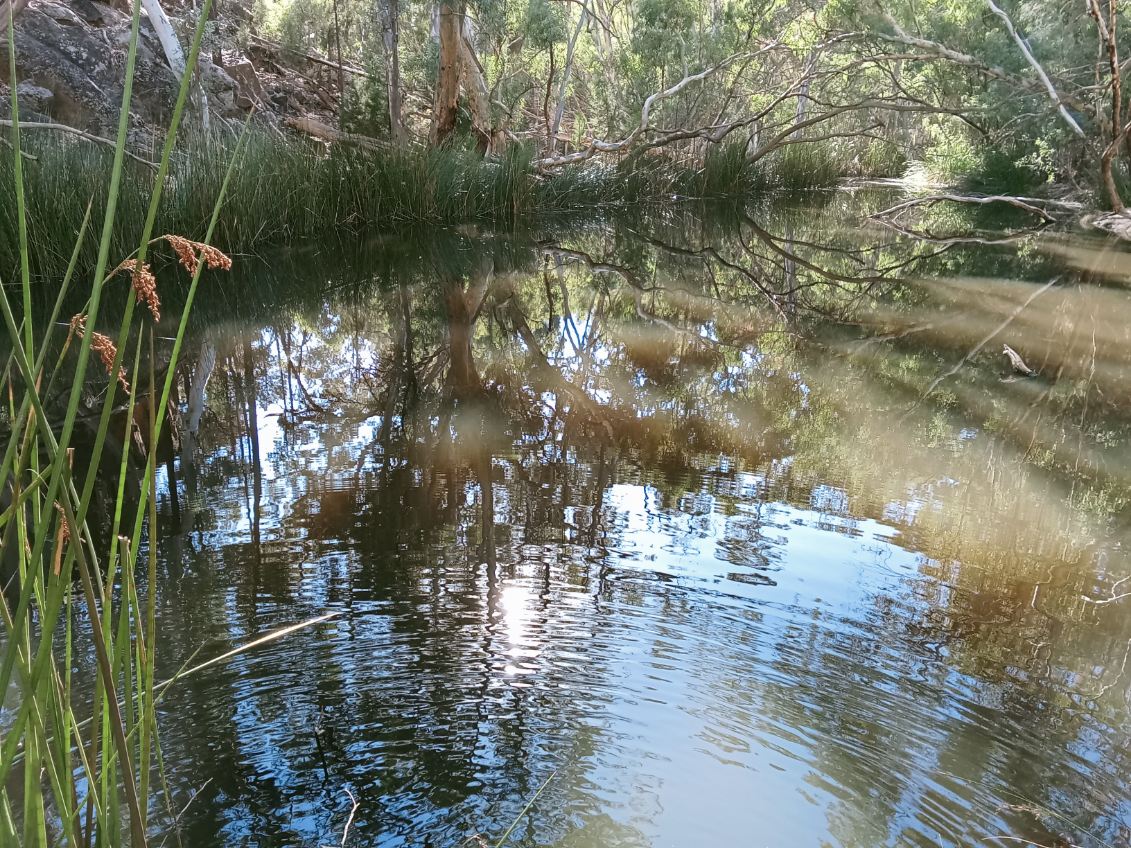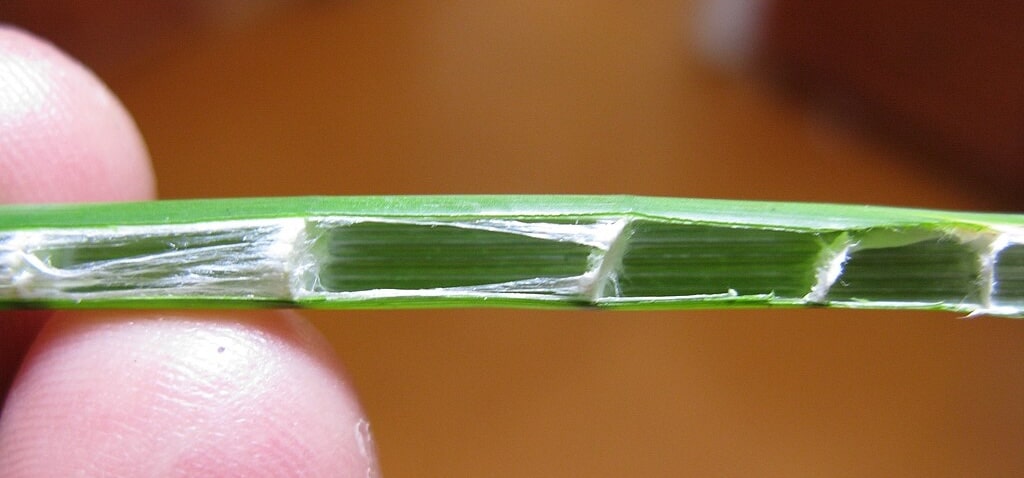Wilpena Gap’s ‘Big Pond’ as I call it, sits in a peaceful setting just meters off the dirt road that takes you into the Pound from the tourist village, and this surely must be the most visited pond in the Flinders. It’s filled by water from Wilpena Spring which is situated in the Pound as close as the creek gets to the former Hills homestead and with probably a much larger contribution from underground flow.

Below the pond, the creek continues for a bit further but it very rarely flows through the camping area these days due to the higher demand for water and more drier years. As far as I know, this is the biggest pool in the Flinders apart from the comparatively enormous pool of Artipena Spring which lies 50 km further downstream on Martins Well. Terrapinna Springs in the far northern Flinders would be bigger except that its area isn’t consistent like it is with the Big Pond. That’s also excluding the mine lakes and Aroona Dam at Leigh Creek, and Hawker sewerage ponds – often a good place for birdwatching.
With no evidence known to suggest otherwise, I can only assume that Wilpena’s pond was dug out by machine and most likely in 1947-48, to supply water to the ‘Wilpena Pound Pleasure Resort’ being established by Bonds Tours at that time. Even today, it still acts as the sole source of water for the much-expanded resort and that helps explain the prominent ‘No Swimming’ sign next to the pond – it’s what people drink. (In recent years, booked in campers are supplied a free 10 L boxed water presumably as precautionary measure against potentially harmful contamination.) But the best part of this story is still to come!

The pond is screened on more than three sides by a 2 m tall curtain of green ‘rushes’ and as I went around to the far bank to get a gps reading, two kangaroos, which seem to love eating the plant, at least during a drought, reversed out of the plants, both looking slightly sheepish if that is possible of ‘roos.
But what I wanted to know was, just what species of rush is this? I knew someone who might have told me but felt too embarrassed to ask. Well, just after 8 pm the same day, I was sitting in the car and scanning through a book on the reeds and sedges of New Zealand when I spotted a photo of brown bowing flower heads. This is it?
I immediately opened the bible – a folder of plastic sleeved pages and each with a composite of information, diagrams, photos and the S.A. distribution map for each of the thirty or so species recorded in the Flinders north of Pichi Richi. And there it was: a similar photo but not in colour. I’d previously missed it and mainly I think because I had developed an inexplicable distaste of its genus name, instead favouring the species starting with names like Cyperus, Schoenus and Eleopcharis.
There it was with, on top of the page and in my own handwriting, the words: ‘the most aquatic and easily recognisable [of the sedges and rushes in Australia] – Nick Romonowski’, NR being an expert in the field and author of a popular field guide now long out of print. While most other species are likely, at least at first, to have you peering through a 10x magnifying glass, this one has three obvious features for identification – its bowing inflorescences, its easily seen ‘cross veined’ stems and being perhaps the only sedge or rush needing to be in water to grow and not just next to it. But there’s also something else about it….

Despite having the round stems that help identify the rushes, this plant is a sedge despite not having the triangular stems of sedges. (You may know the poem ‘ Sedges have edges while rushes are round, while grasses have knees that bend to the ground’ and best chanted in E flat. But the sedges are notorious for breaking the rules and the flat sedge (Cyperus vaginatus) a very common sedge in the ranges, also has round stems.
A couple of days after this, I was at the pond again when an older couple stopped to admire the scene and the man asked “Do you know what plant that is?” “Yes, Machaerina articulata’ I said in the casual manner of someone long-versed on the topic, while laughing quietly to myself at my luck and the pretense of it all. He told me that he volunteered one day a week at the Brisbane Botanic Gardens so I thought it only fair to come clean and told the real story.
If you’re ever up that way, make sure to go and visit the Big Pond and admire those ‘reeds’. And tell them I sent you – you never know.
Editor’s note: If you’re interested in exploring the more remote springs and waterholes of the Flinders, Mike regularly visits these areas and always appreciates support. I can attest that the experience of navigating between new and unknown water sources is a great way to connect with the country. Please note however that these trips are not affiliated with Adelaide Bushwalkers and participants go at their own risk. They would be advisable only for people with significant experience in remote locations. Contact Mike at mhround@yahoo.com.au for more information.
Next: Late Afternoon Atop Patawarta


Hi Mike, thanks for the article on the Wilpena creek big pond and the Machaerina articulata (Jointed Twig-rush). Info from Dept Environment and Water says that the pool is 40 metres deep! Given the depth, it’s unlikely to have been dug out by machine in the 1940s. Although it’s highly likely that it was altered in some way when they began using it as a water supply for the Wilpena Resort. cheers, Glenn
A great read, thanks Mike!
Hi Glenn and Jules,
Thanks for your comments! It’s always heartening for an author to get feedback. Yes, I just followed up on the DEW link to Wilpena for the first time to find that the water problem is due to iron bacteria (our home bore briefly had that a few years ago). I think perhaps that the 40 m may be referring to the depth of the groundwater supplying the spring. I will look into it a bit further.
Thanks again, Mike
Yes you are right Glenn, that pond is 40 m deep as you said and that is a truly extraordinary thing. My apologies for doubting you.
Just on the jointed twig-rush, it’s called a rush I suppose because it looks like one but it is in one of ten genera included in the sedge family Cyperaceae. The rushes are family Juncaceae. The architecture of the flowers is what separates the two families.
I forgot to mention, or at least it didn’t occur to me at the time, but the plant highlighted here is normally only to be found in S.A in the Murray River and SE districts.
With regards the depth of the pond, a local National Park ecologist recently told me that the source of 40 m depth is unknown and considered it to be highly unlikely. Perhaps one day, someone will plumb it.